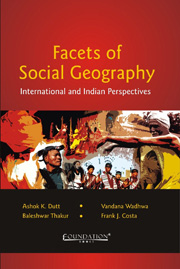Book contents
- Frontmatter
- Contents
- Foreword
- Preface
- Acknowledgements
- List of Contributors
- I Introductory Framework: Allen G. Noble's Contribution to Social Geography
- II Conceptual and Theoretical Basis of Social Geography
- III Social Geography from a Global Perspective
- IV Social Geography in the Indian Context
- 15 Socio-cultural Regions in Pre-historic and Historic India
- 16 Distinct Regional Cultural Identities of India Based on Religion and Language
- 17 Linguistic Diversity Changes in India: A Regional Analysis, 1971–2001
- 18 The Geography of Folk Art in India
- 19 Indian Dance: Classical Unity and Regional Variation
- 20 Space, Gender and Social Value: Analyzing Gender Inequalities in Relation to Space
- 21 Encountering Reservation and the Reimagining of Caste
- 22 Spatial Patterns of Crime in India
- 23 Rural Human Resource Development in India: A Spatio-Temporal Analysis
- V Indian Social Geography: City and State Context
- Index
17 - Linguistic Diversity Changes in India: A Regional Analysis, 1971–2001
from IV - Social Geography in the Indian Context
Published online by Cambridge University Press: 05 June 2012
- Frontmatter
- Contents
- Foreword
- Preface
- Acknowledgements
- List of Contributors
- I Introductory Framework: Allen G. Noble's Contribution to Social Geography
- II Conceptual and Theoretical Basis of Social Geography
- III Social Geography from a Global Perspective
- IV Social Geography in the Indian Context
- 15 Socio-cultural Regions in Pre-historic and Historic India
- 16 Distinct Regional Cultural Identities of India Based on Religion and Language
- 17 Linguistic Diversity Changes in India: A Regional Analysis, 1971–2001
- 18 The Geography of Folk Art in India
- 19 Indian Dance: Classical Unity and Regional Variation
- 20 Space, Gender and Social Value: Analyzing Gender Inequalities in Relation to Space
- 21 Encountering Reservation and the Reimagining of Caste
- 22 Spatial Patterns of Crime in India
- 23 Rural Human Resource Development in India: A Spatio-Temporal Analysis
- V Indian Social Geography: City and State Context
- Index
Summary
India is a land characterized by “unity in diversity” amidst a multicultural society. This is symbolized by variety in culture such as different languages, religions, castes, house types, dance forms and dietary patterns (Noble and Dutt, 1982). Of these cultural traits, language is an important instrument of cultural identity since it is through this medium that different groups of people communicate with the world and express a sense of identity to a place. Often, social tensions emerge when a certain segment of society feels ostracized from social and economic processes of development due to lack of knowledge of the dominant and prevalent language. This often leads to granting linguistic minorities special privileges to accommodate them in the process of mainstream national social and economic development.
India is considered to be the world's most linguistically diverse nation. The Eighth Schedule of the Constitution specified 14 major languages and a concerted effort has been made to fully develop all these languages in the interest of national integration and development. Subsequently, eight more languages were included in the schedule and these were: Sindhi (1969), Konkani, Manipuri and Nepali (1993), Bodo, Dogri, Maithili and Santhali (2003) (Sengupta, 2009). According to the 2001 Indian Census approximately 96.6 percent of the Indian population spoke these 22 scheduled languages with another 100 non-scheduled languages spoken by a minimum of 10,000 people in different regions (Census of India, 2001).
- Type
- Chapter
- Information
- Facets of Social GeographyInternational and Indian Perspectives, pp. 334 - 349Publisher: Foundation BooksPrint publication year: 2012
- 1
- Cited by



